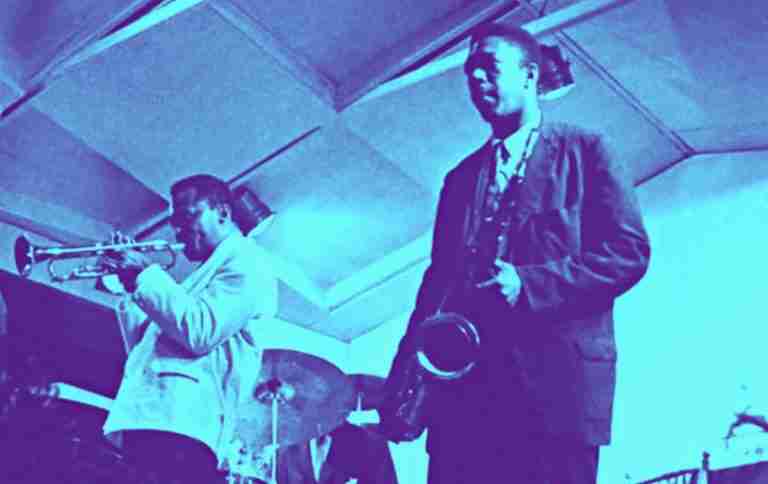There are a lot of skills you need in jazz improvisation…Developing great ears, a knowledge of tunes, instrumental technique, and a mastery of jazz language…
But there’s one question that gets to the heart of the matter for any soloist…
Can you come up with interesting musical ideas over a single chord?
Without the aid of a tune you’ve memorized, a familiar chord progression, or a guide tone line to follow, can you tell a musical story on one static sound?
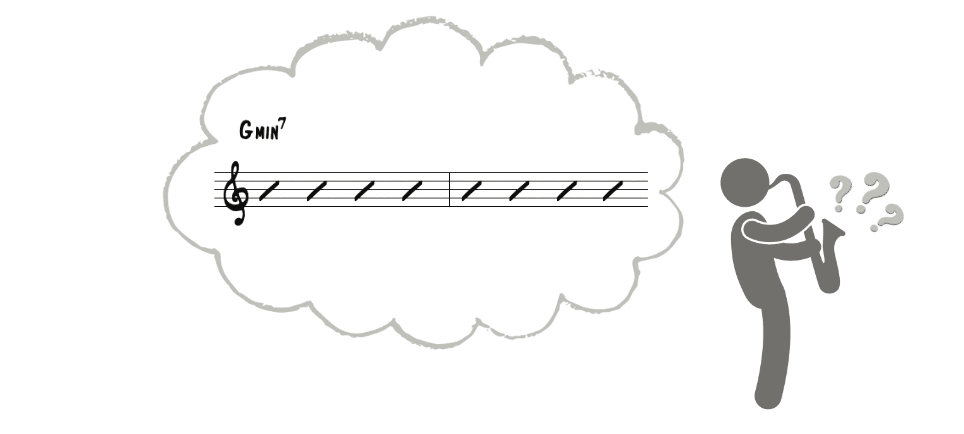
This is a situation that gets to the foundation of what it means to improvise, and it’s one that you’ll encounter in modal tunes and many other standards in the jazz repertoire.
What many players don’t realize is that it’s surprisingly harder than it sounds!
That’s why today we’re going to look at how two musical masters – Miles Davis and John Coltrane – approach the art of playing and creating musical ideas over a single chord.
Let’s get started…
The tune: Milestones (New)
The tune we’ll use in this lesson to explore some techniques for improvising over static chords is Milestones, (the new version) recorded by the Miles Davis sextet in 1958.
Milestones is often referred to as the first modal tune because the progression doesn’t follow conventional harmony, instead you’ll find long stretches of a single chord.
As Miles says in his autobiography:
“This was the first record where I started to really write in the modal form and on ‘Milestones,’ the title track, I really used that form. Modal music is seven notes off each scale…a scale off each note.”
Take a listen to the tune here:
The harmony
The tune has a 40 bar AABBA form that consists of only two chords, you might see it written out like this in fake books:
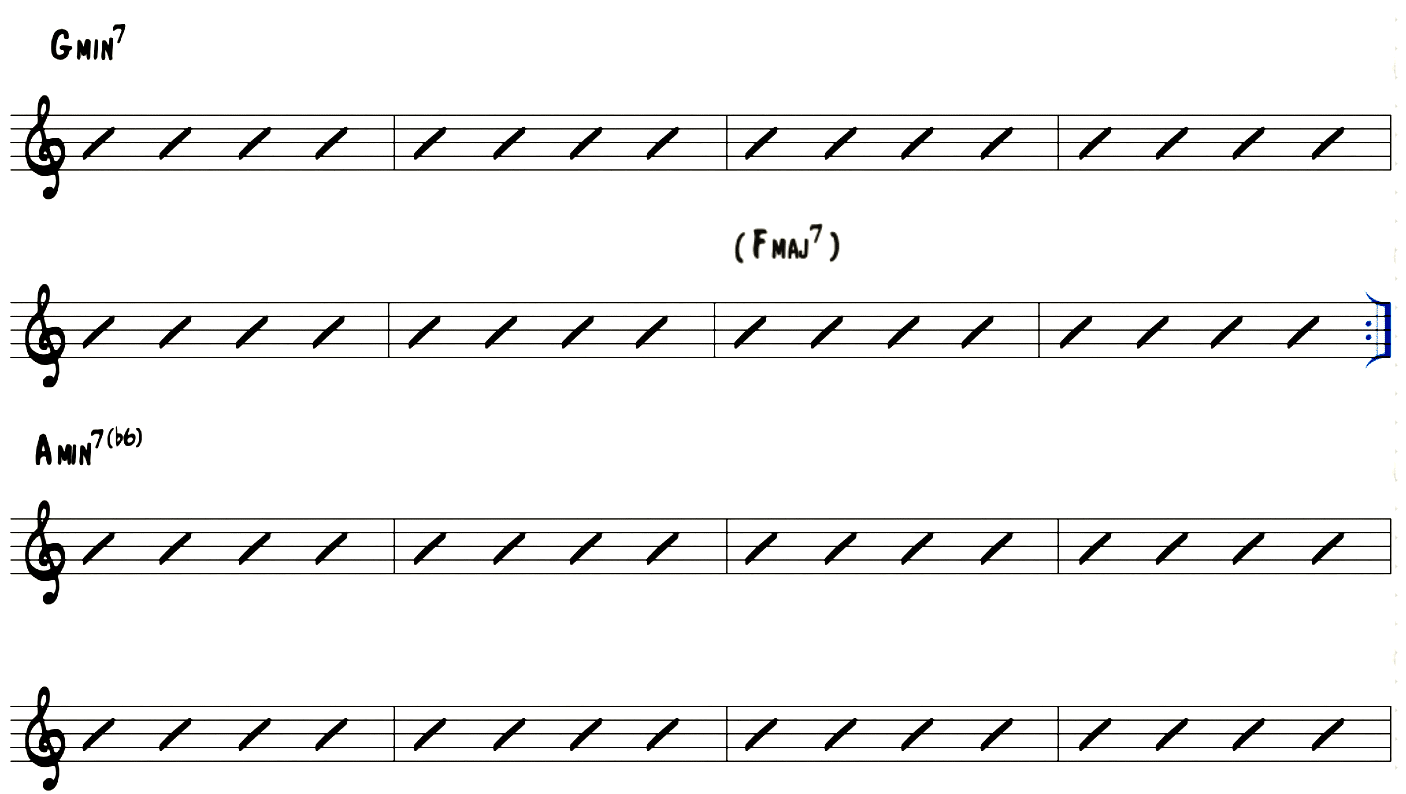
This is an ideal tune to study how musical masters construct melodic ideas over long stretches of a static sound because it only has two chords!
Despite its sparse harmonic content however, it can be surprisingly challenging to come up with melodic ideas in your solos. Let’s take a closer look at the harmony…
The problem with only thinking Dorian
The typical approach you’ll find in fake books for the first chord is G minor (dorian) or C7 and the second as A-b6 (aeolian). And like any modal tune, the typical advice is to simply use a scale to create all of your musical ideas.
Listening to this tune however, you might notice that the first section doesn’t exactly sound “minor” in a way that you’d expect…

The A section can sound different – under the melody it sounds major or V7, while under the soloists sounds more minor. And this is why the A section is sometimes notated as a “C dominant chord.”
This goes back to what the rhythm section is doing and how the pianist is voicing the chords. Take a listen to what the pianist (Red Garland) is playing under the melody:

Mirroring the melodic line, he is playing diatonic arpeggios along with a C in the bass on beat 4 of the second measure, giving the A section a V7 kind of sound – C7sus…

One reason for this open sound is that there is no V7 sound that resolves to minor or typical progressions that tonicize the minor chord, thus you get a more open sound.
You might also notice that there is a brief resolution in the melody to FMaj (or A minor) at the end of 8 bars.
Because of all of these factors, restricting yourself to only the Dorian mode can limit your creative options. In fact, trying to create an entire solo using 7 consecutive notes of a scale with no relation to the overarching harmony or a sense of melody puts you in a musical box.

To escape this, we need to understand where the dorian mode comes from…What does dorian mean? This mode is a part of a larger major key, in this case the second diatonic mode or ii chord in the harmonic world of F Major:

Because the harmonic backdrop and voicings are not strictly in G minor (or resolving to G minor), but instead more open and moving around diatonically, you can draw from the harmonic relationships found in the larger key of F Major:
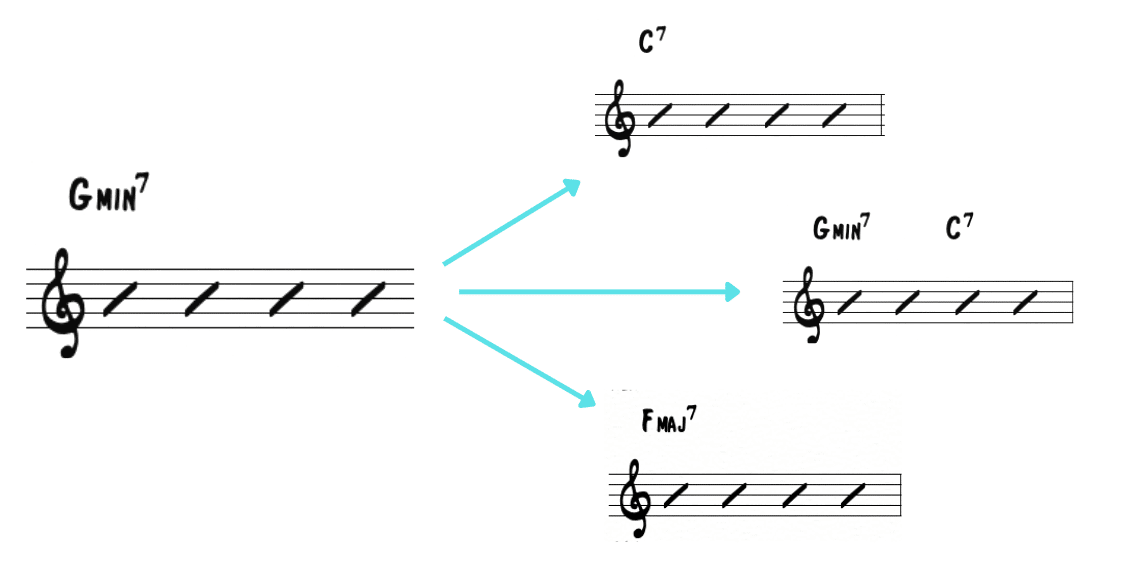
This includes V7 language, ii-V language, and even Major language and the related techniques from the world of F Major – something that the solos we’ll look at below utilize to the fullest extent.
The ‘B’ section
On the other hand, the ‘B’ section does have a definite minor sound…

This is a minor b6 sound or aeolian mode.
Another notable aspect of the ‘B’ section is the ostinato bass line – changing the time feel as opposed to walking bass, also lending a more harmonically open feel:

This lends itself to a rhythmic and phrasing freedom as opposed to the opening section and serves as a nice harmonic and rhythmic contrast between the two sections of the tune.
Again, here you aren’t going to rely on just one scale or mode to select the notes of your solo. As we’ll show you in the solos below, you can apply standard minor language and techniques to this section.
*If you’re looking to truly master the ins and outs of jazz harmony, be sure to check out our newest course Jazz Theory Unlocked!
Two Solo Approaches
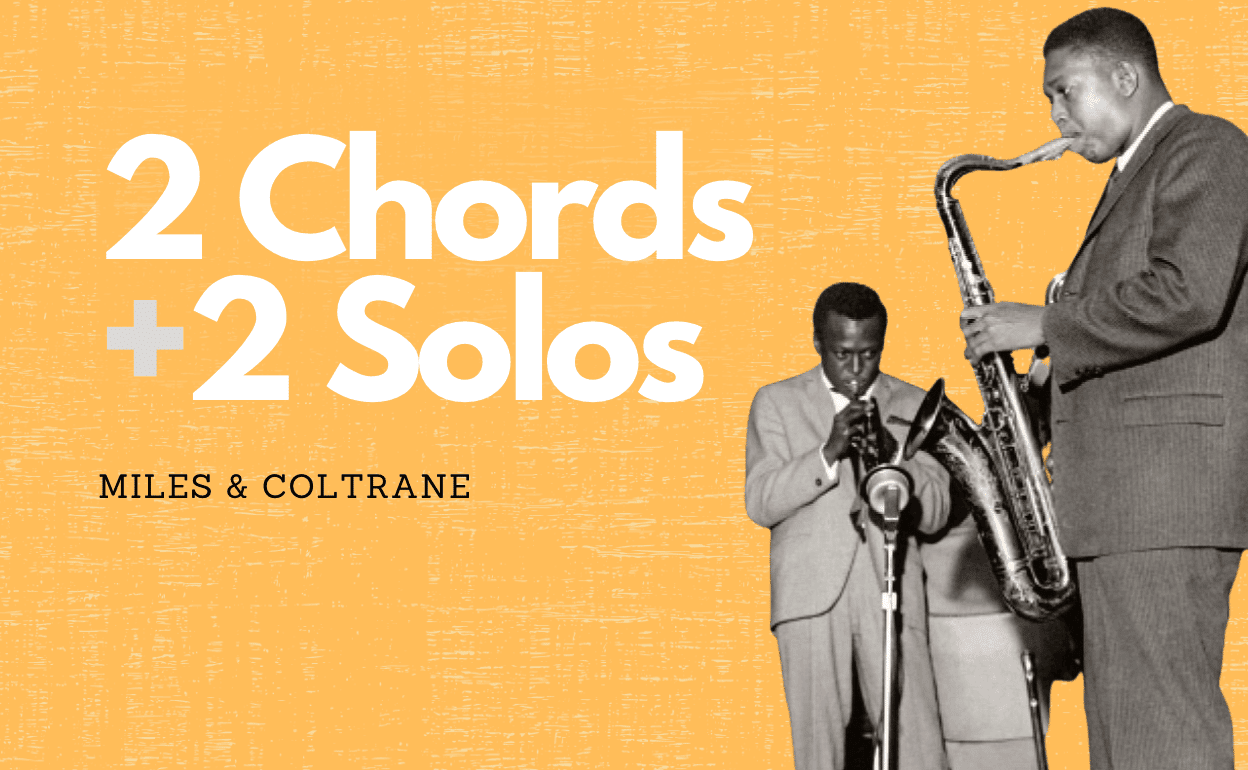
So what do you play over these two individual sounds that seemingly don’t have any harmonic direction?
And more broadly, how do you approach a long stretch of any chord that doesn’t change or give you a chord progression to follow?

Rather than taking one scale and trying to piece together a solo, let’s take a more musical approach and study how some of the best musicians have solved this exact problem.
Below we’ll focus on the specific way Miles Davis and John Coltrane navigate the two static sounds in Milestones and the exact techniques they use to create compelling musical ideas.
Take a listen to the opening section of each solo below…
Miles Davis on Milestones
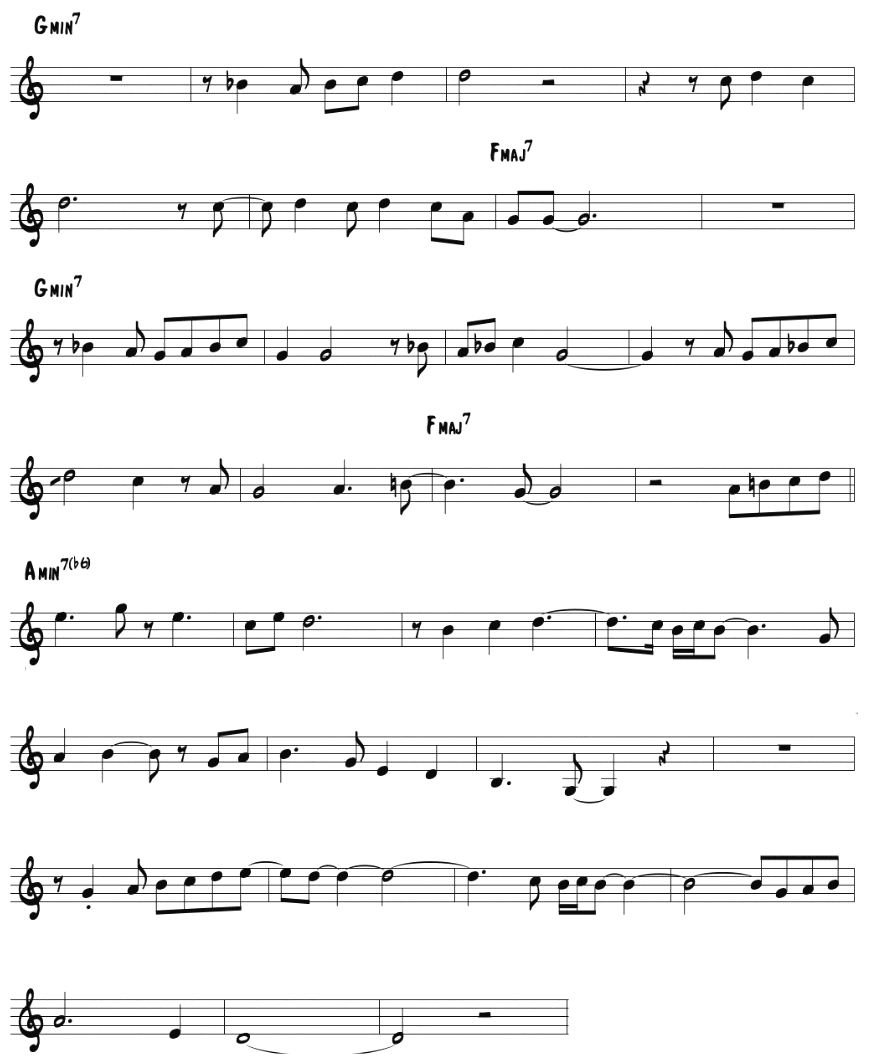
Now contrast this with what Coltrane plays over the same 32 bars…
John Coltrane on Milestones
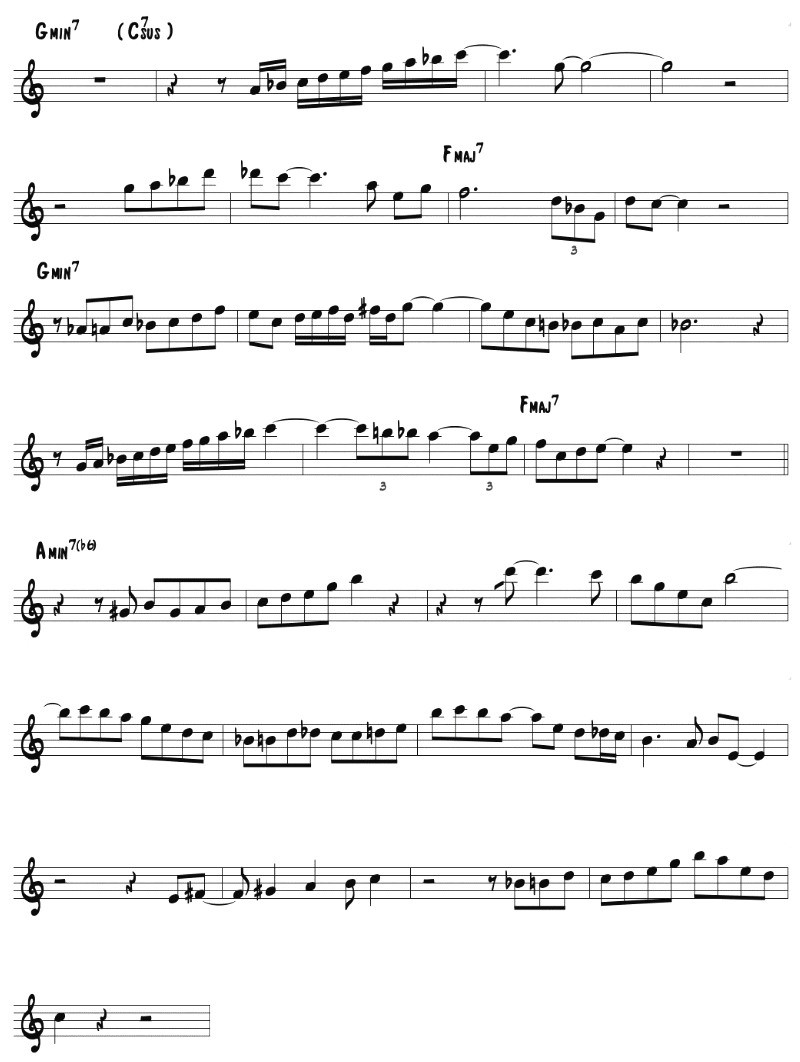
In these two excerpts you can hear how each player approaches this static sound in a unique and different way.
Miles uses a more motivic and sparse approach to the static chords while Coltrane utilizes a more linear approach that draws upon familiar jazz language.
Below we’ll extract the specific musical techniques that each of these masters use in both of their solos to create compelling musical ideas…
4 Improvisation Techniques
From both solos on Milestones, we can isolate four musical tactics for navigating a single sound – ideas that you can begin applying today in the practice room.
Let’s jump in…
Technique #1: Highlight Specific Chord Tones

One misconception in creating a solo is the belief that you have to conjure up complex ideas from the start or that you need to constantly create long sequences of eighth note lines.
However, this is not the case at all!
To create a compelling solo, you can actually start from a much simpler place – with one note. A specific chord tone or harmonic color that you are hearing and then build your ideas around.
To see what I mean, listen to how Miles approaches the G minor chord in the second chorus of his solo:

In this phrase Miles is emphasizing the unique color of the 9th on minor:
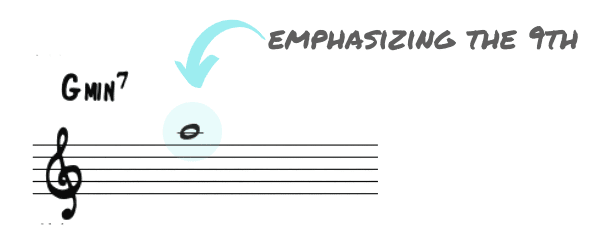
He continues with this theme in his next phrase as well:

Rather than trying to create lines by piecing together scales or individual notes, Miles is starting with one sound he is hearing and then shaping his phrases around it – in this case an A over G-7.
He then shapes his phrase by utilizing the notes of the surrounding arpeggios – first using the 5th and 7th of G minor (D and F) and then descending with G E C to A, hinting at a temporary resolution to F Major.
An easy way to start creating melodic ideas is to select one chord tone to highlight over the underlying chord. Rather than trying to create lines with individual notes, simply think “I’m going to base my melodic idea around this one note.”
Highlighting diatonic structures
Along with a single note, you can also utilize pairs or groups of diatonic chord tones to create your musical ides.
For example, using the triad, diatonic 7th arpeggios, or the upper structures of the chord. This will narrow down your options and give you a melodic and harmonic focus for your ideas.
Check out how Miles does this with the upper structure notes of the minor chord on the B section:

In this line Miles is emphasizing the 9th and 11th on top of the underlying A minor chord. He does the same in his next phrase as well:

Practice ideas:
Implementing this technique into your solo approach requires that you have knowledge and technical facility for chord types in all keys, and also that you can instantly hear these sounds.
This requires some specific practice exercises:
- Begin by visualizing different chord tones on a single chord (Major, minor, V7). You need to be able to instantly visualize the chord tones of a chord in any key.
- Next, you need to be able to play these on your instrument in all keys.
- Finally you need to ingrain the unique sound of each chord tone in your ear so you can access it on the fly in your solos without thinking about it…this means ear training.
These three elements can even be practiced at the same time with the aid of a piano – play the chord, visualize a specific chord tone, then hear, sing, and play this note over the underlying chord.
Then as you implement this idea in your solos…
- When you listen to a chord, which note are you hearing in your head? Which chord tone do you naturally sing or gravitate to?
- Practice creating musical ideas around this chord tone. You can utilize approach notes, arpeggios, and scale fragments to expand your ideas.
#2) Motivic Development

Along with highlighting individual chord tones, the next technique in creating musical ideas over a static chord revolves around melody.
Specifically creating simple melodic statements and developing these ideas throughout the course of your solo.
This is an important point for any improviser, especially when you’re playing modal tunes where there is very little harmonic material to work with.
As Miles says in his autobiography:
“…The challenge here, when you work in the modal way, is to see how inventive you can become melodically. It’s not like when you base stuff on chords, and you know at the end of thirty-two bars that the chords have run out and there’s nothing to do but repeat what you’ve done…”
Remember, the goal of your solo is not to simply play the “right” notes or string together scales, but to create actual melodic ideas…motivic development!
Miles employs this technique in his solo in a masterful way – every idea that he plays is a motivic idea that he develops throughout the phrase. For instance, check out the first phrase in his solo…

The material he’s drawing from here is surprisingly basic, the first 5 notes of the underlying G minor chord:

Here he expands on the idea of highlighting a goal note, creating and developing motivic ideas with the D as the focus note.
It’s also important to study how Miles approaches 8 bars of music and makes a complete musical phrase.
He begins with a simple melodic statement, plays an answer to the initial idea, and then concludes his phrase:
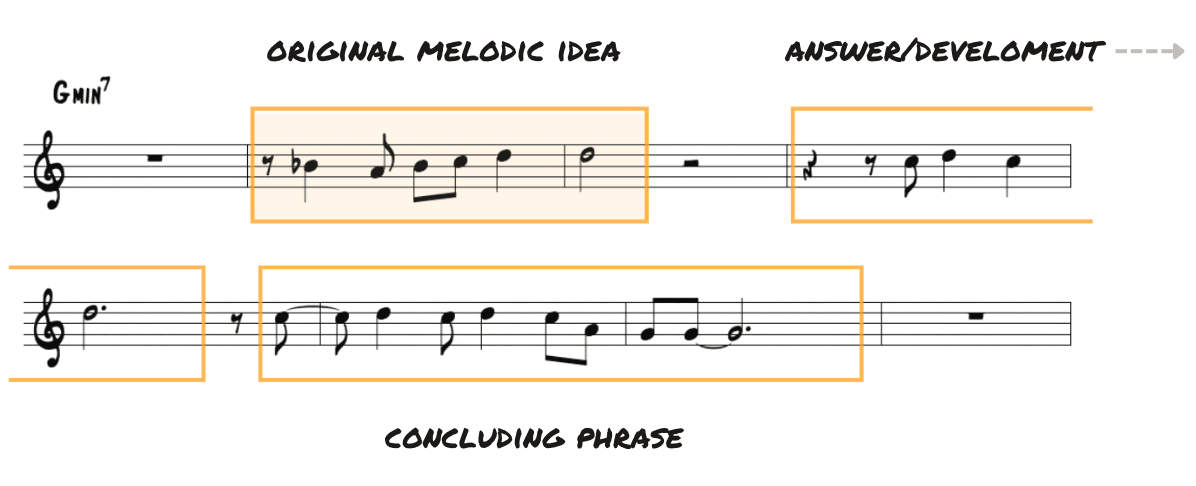
An initial idea is developed and logically concluded over the space of 8 bars.
He utilizes the same melodic and motivic approach in the next phrase as well, this time centered around the root of the underlying sound (G) and utilizing the first 5 notes of the chord:

Again he applies the same phrasing format as the first 8 bars, playing a short initial idea, answering it, and then concluding the phrase with similar material.
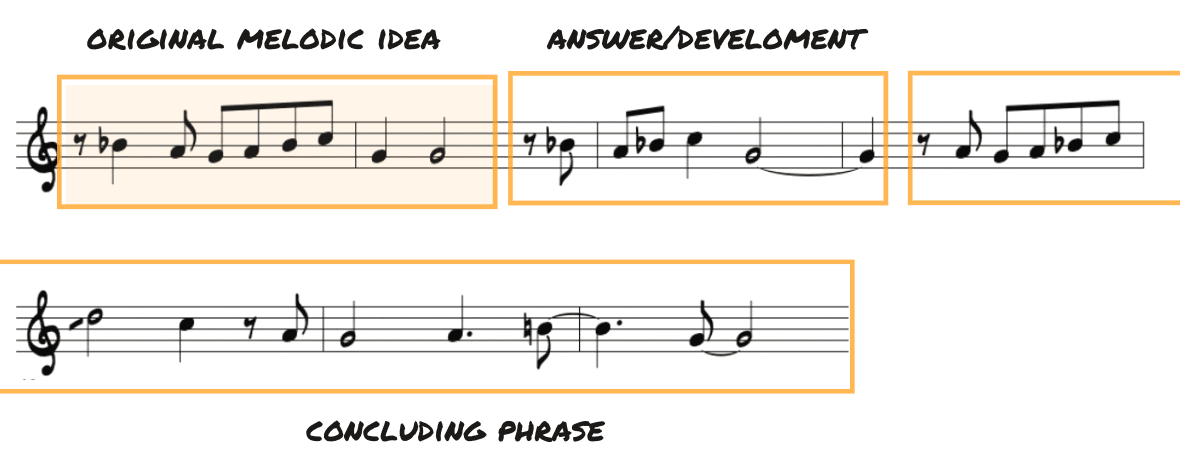
Notice how there is repetition and development of the basic idea. The theme is given time and space to naturally evolve…something that many players forget to do.
Miles also shows that you don’t need a lot of notes or harmonic complexity to create strong musical ideas – make a simple statement, stick with it, develop it, and then conclude your phrase.
Let’s take a look at one more example from Miles over the Third example using the same 5 notes, this time utilizing a descending 5th interval:

In this line, can you identify the initial idea and hear how he develops it over the course of his 8 bar phrase
Even though these ideas may seem basic at first glance, this approach is much more effective than a mishmash of random ideas or a constant string of 8th notes played without direction or intent.
Practice ideas:
To build your melodic skills you need to narrow down your musical options, this way you can focus on making music with a few simple sets of notes, rather than getting bogged down with multiple chords and scales at once.
- Strive to play a melodic idea that you are actually hearing rather than something that you are thinking or trying to construct with scales or theory.
- Remember it’s not just the notes, the way you play your ideas makes the music – your sound, rhythmic clarity and intent, mean what you play!
- To encourage your creativity, think about different patterns, intervallic combinations, try ascending 3rds, a 5th, wider leaps, or approach notes.
- Stick with and develop your idea! Think of it like telling a logical story, one idea leads into the next, developing over time.
The goal is to develop the ability to create musical ideas and be creative with the basic chord tones of any sound, the root triad or arpeggio – to create motivic ideas and phrases with the building blocks of a sound.
#3) Rhythm & Phrasing

When it comes to creating a solo and developing musical ideas on a single chord or any progression, it’s not just about the notes you choose…
An effective solo is also about the rhythms that you play and where you place your ideas within the larger form – something that many players tend to ignore!
This is especially true when it comes to creating melodic ideas over a single chord. Because the harmonic content of the tune is not changing, the rhythmic elements of your playing are vital to adding interest and motion to your ideas.
As a soloist, you first need to determine how you are going to approach the rhythmic content of an individual measure. Specifically, which rhythms you want to play and where you want to start:
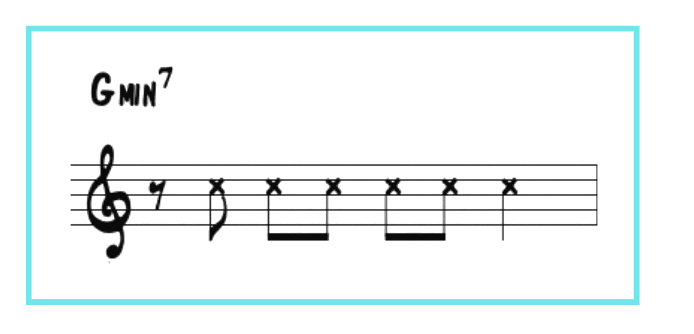
Are you going to:
- Use Quarter notes, 8ths, 16ths, or triplets?
- Sustain notes or play shorter notes?
- Start on a downbeat or an upbeat?
Then you need to consider where you are going to place your musical statements within the form of the tune. For instance, in the context of 4 or 8 measures of music, where are you going to place your phrases?:

Are you going to lead into or anticipate a particular measure? Are you going to play at the beginning of the form? Are you going to play multiple ideas? Are you going to leave space…
All of these rhythmic and phrasing factors will contribute to your overall musical statement. With this in mind, let’s look at rhythmic content of both solos…
Check out what Miles plays rhythmically in the opening phrase of his solo:

Even though he is not playing a lot of notes, you hear clearly defined rhythmic ideas. Also, notice how he starts each of his ideas on upbeats.
He continues this theme of upbeats in his second phrase as well, adding continuity to his lines:

Now compare this to the rhythmic content of Coltrane’s opening phrase:

Coltrane starts his phrase with 16th note run and then moves to mostly straight ahead 8th note lines. Then in his second phrase he begins with 8th note lines interspersed with 16ths and then ends the phrase with another 16th note run and some triplets:

Notice too how Miles and Trane, while rhythmically different, both play engaging phrases that naturally begin and conclude within 8 bars of music.
This should be your goal as you craft your own musical phrases!
Rhythmic contrast on the B section
Because the B section features an ostinato bass pattern that begins on beat two, the feel here is much freer.
On top of this Miles takes a more laid back approach to his phrases:

Here he is almost floating over the time, playing his ideas with a relaxed freedom as opposed to the melodic and rhythmic precision of the A section.
Practice ideas:
- To begin, simply become aware of the rhythmic content of your musical ideas.
- As you improvise, start with a particular rhythm in mind. For instance, “I’m going to start my phrase on the ‘and’ of one,” or “I’m hearing triplets”…
- Listen to the time of the rhythm section and hear the chords and form go by…What rhythmic ideas are you hearing?
- Strive to continually learn and develop new rhythmic ideas to add to your vocabulary!
#4) Implying related chords

As an improviser, one of the hidden truths to soloing is that you don’t always have to stick the written chord progression…
In fact one of the main techniques Coltrane uses to create melodic lines over the static G-7 sound is implying related chord progressions from the larger key of F Major…
As we showed earlier, the open modal structure utilizes diatonic material from this ‘parent key,’ and Coltrane hints at this in one of his phrases, playing diatonic arpeggios…
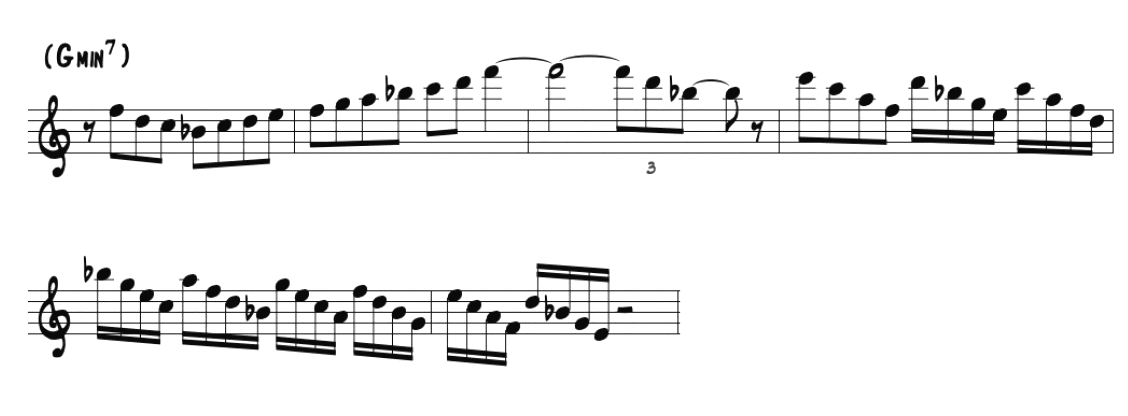
Below we’ll show you exactly how Coltrane applies harmonic tactics and devices from the world of F Major to create linear motion and melodic interest in his lines.
One of the secrets to creating longer lines over a static chord isn’t thinking of more notes or using specific scales…It’s implying related progressions over a particular sound.
Over the underlying G minor sound in Milestones Coltrane utilizes 3 related chords and progressions:
- The dominant sound – (C7)
- The related ii-V in the tonic key (G- C7)
- And a ii-V-I resolving to the I chord (G- C7 F Maj)
Let’s take a closer look at how Trane employs these in his solo…
1. Implying V7 language and ii-V’s
The first way Coltrane creates more melodic and harmonic options over the underlying minor chord in the A section is by utilizing related dominant language.
In the case of G minor he applies C7 language and techniques. To hear what I mean, take listen to the phrase below:

Here he applies language from the related V7 chord (C7), beginning on the G and descending while utilizing half-step motion from the root to b7 like a bebop scale.
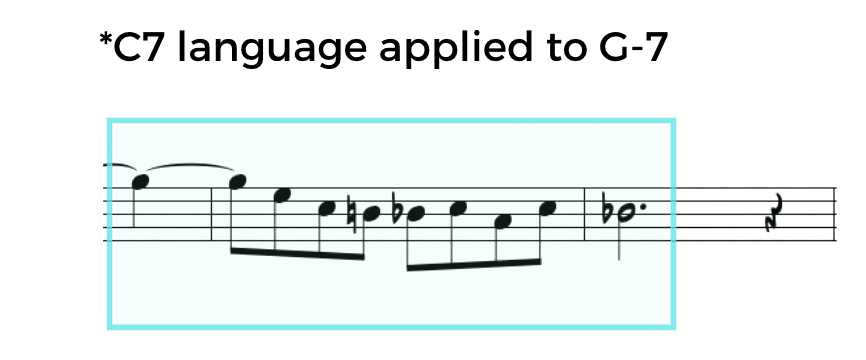
Along with utilizing related V7 language, he also implies ii-V material over the static minor chord:

In this line he plays an idea in G-7 that resolves in the second measure to C7, ending on the E natural. This transforms the static G minor chord into a progression that has forward motion (resolution) and more melodic options.

2. Using multiple ii-V’s
In the same vein, another tactic Trane uses to create longer lines is to use multiple ii-V’s in a row.
To see what I mean, listen to the line below that begins in G minor:

In this phrase he alternating between ii and the V sound, G- to C7, and utilizing common ii-V language.
To achieve this, he uses minor language, V7 language, and ii-V techniques all wrapped up into one long line:
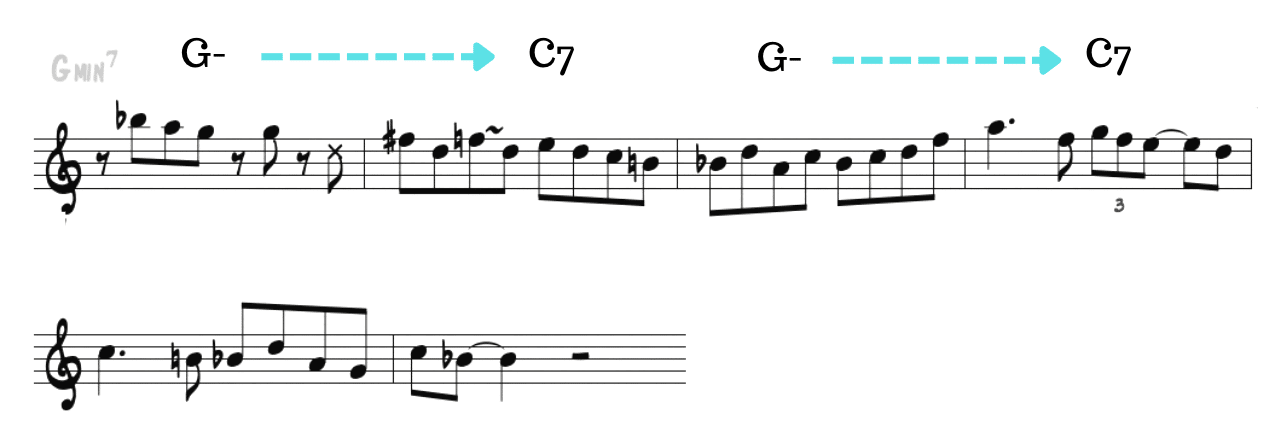
3. Implying ii-V-I
At the end of each 8 bar section in the ‘A’ there is a short resolution to F major and in these spots Coltrane applies ii-V-I language.
Check out this line from the opening chorus of his solo:

Over the G-7 sound he inserts a ii-V-I progression ending on the last bar. Notice how he emphasizes the b9 on the implied V7 chord that resolves to the tonic:

And here’s another example where he again implies a ii-V-I progression in the same spot in the form:

You’ll realize that minor, V7, and ii-V in a key are all related and can often be used interchangeably to create musical ideas and linear motion in your solos.
4. Applying minor language to the B section
And finally, let’s check out how Coltrane approaches the B section of the tune…
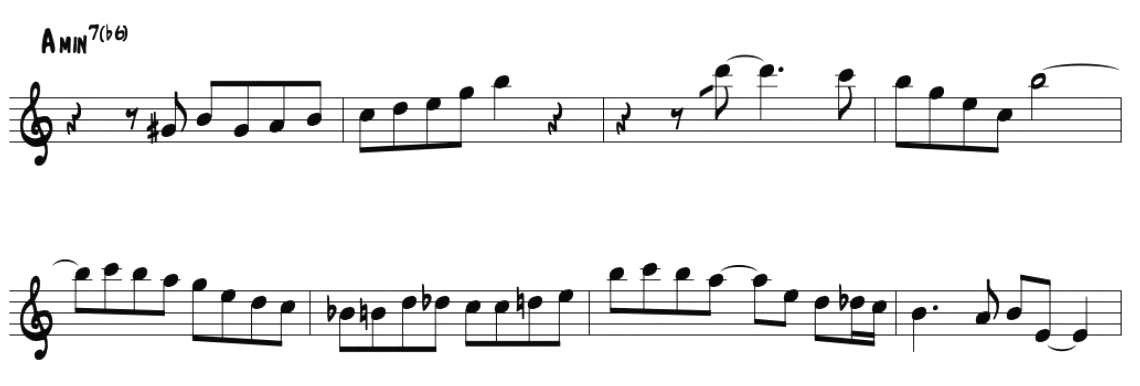
Rather than restricting himself to a single mode (aeolian) or scale, he instead applies standard minor language and techniques here.
In the first four bars he is playing A minor arpeggios up to the 9th and 11th – simple material applied in a melodic way, not necessarily b6 minor, rather a typical ‘minor’ approach.
The in the final four bars he utilizes enclosure to create more linear motion and a longer line:

Practice ideas
To utilize the technique of implying related chord progressions to a chord requires some specific practice steps:
- First you need a harmonic understanding of diatonic progressions in Major harmony and be able to visualize them in any key.
- Next you should develop language for Major, minor, and V7 chords individually.
- Then you need to learn ii-V language and techniques
- The key is understanding how these sounds relate to each other in a diatonic sense (ii minor, V7, and Major in one key) and can be used interchangeably.
- Practice applying ii-V language to minor chords
- Practice applying V7 language to minor chords
- Practice applying minor language to V7 chords
Remember, for the best players, creating long lines isn’t about adding more notes or thinking of notes one at a time, rather applying harmonic progressions to static chords and utilizing the related language and techniques.
Start with one chord
At the most basic level, anything that you improvise starts over a single chord…
This is where your creative process begins for any solo.
From this single chord you evolve to dealing with multiple chords and their relationships (progressions) and groups of progressions (tunes).
If you’re serious about effectively building your skills as an improviser, you need to spend time learning to craft musical phrases over a single sound!
To start, use the four techniques from Miles’ and Coltrane’s solo over Milestones to build your skills. As you head into the practice room remember to:
- Begin with single chord tones
- Prioritize melodic development
- Utilize rhythm & phrasing
- And incorporate related progressions to create longer lines
And if you’re looking for a more in-depth method for improving as an improviser and building techniques for creating melodic ideas over individual chords and progressions be sure to get our course Melodic Power.
